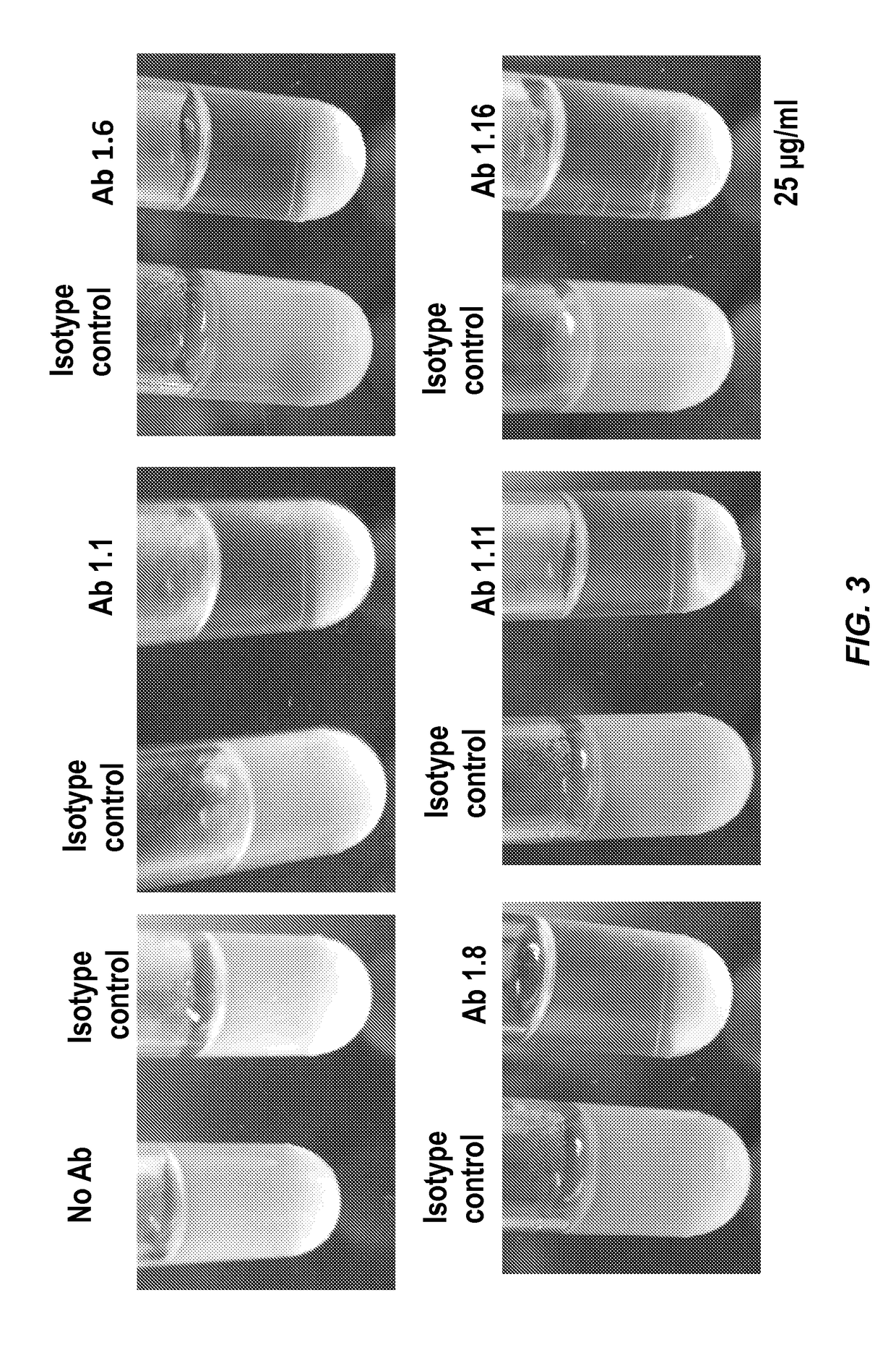Passive immunization for Staphylococcus infections
a staphylococcus and immunization technology, applied in the field of staphylococcus immunization, can solve the problems of infection rate, osteomyelitis (om) remains a serious problem, amputation or death, etc., and achieve the effects of promoting phagocytosis, adhesion and immune evasion, and hindering one or both cell division and biofilm formation
- Summary
- Abstract
- Description
- Claims
- Application Information
AI Technical Summary
Benefits of technology
Problems solved by technology
Method used
Image
Examples
example 1
on of Antigen
[0126]A recombinant form of the entire amidase domain of S. aureus autolysin that includes a hexa-histidine sequence near its N-terminus (His-Amd) was prepared. The open reading frame for His-Amd was designed by collecting known sequences of S. aureus autolysin, determining the consensus protein sequence using Geneious™ software, and then optimizing codon usage for expression in E. coli. The encoded consensus protein and encoding open reading frame sequences for His-Amd are identified as SEQ ID NOS: 1 and 2 below.
[0127]
SEQ ID NO: 1 (Hex-histidine leader sequence plus Autolysin aa 198-775)MHHHHHHSASAQPRSVAATPKTSLPKYKPQVNSSINDYIRKNNLKAPKIEEDYTSYFPKYAyRNGVGRPEGIVVHDTANDRSTINGEISYMKNNYQNAFVHAFVDGDRIIETAPTDYLSWGVGAVGNPRFINVEIVHTHDYASFARSMNNYADYAATQLQYYGLKPDSAEYDGNGTVWTHYAVSKYLGGTDHADPHGYLRSHNYSYDQLYDLINEKYLIKMGKVAPWGTQSTTTPTTPSKPTTPSKPSTGKLTVAANNGVAQIKPTNSGLYTTVYDKTGKATNEVQKTFAVSKTATLGNQKFYLVQDYNSGNKFGWVKEGDWYNTAKSPVNVNQSYSIKPGTKLYTVPWGTSKQVAGSVSGSGNQTFKASKQQQIDKSIYLYGSVNGKS...
example 2
on of Mice and Preparation of Hybridomas
[0132]For the initial hybridoma fusion (Fusion #1), six female Balb / c mice were immunized two times with 75 μg of His-AmdR1R2, in the Sigma Adjuvant System (Sigma, Cat. No. S6322) by intraperitoneal injection at seven-week intervals. Two of the mice with the highest titers in ELISA on immobilized His-AmdR1R2 were selected for hybridoma fusion. Each mouse received a final immunization of 350 μg of His-AmdR1R2, i.p., four days prior to sacrifice and hybridoma fusion.
[0133]For the second hybridoma fusion (Fusion #2), Balb / c mice were immunized two times: first dose with 120 μg of His-AmdR1R2-B from GenScript (Lot Number 222933505 / P20011303) in Sigma Adjuvant System (Sigma, Cat. No. S6322), and a second immunization with 100 μg of His-AmdR1R2-B conjugated with Keyhole limpet hemocyanin (KLH) (Imject EDC mcKLH Spin Kit; Thermo Scientific; Cat #77671) at twelve-week intervals. Two of the mice with the highest titers in ELISA on immobilized His-AmdR1...
example 3
ization of Monoclonal Antibodies
[0135]New monoclonal antibodies were screened on multiple related proteins to determine that they recognized native Amd (and not just the recombinant form) and whether their epitope was present on the catalytic (C) or cell wall binding domain (R1, R2 or R3). The proteins used for screening the monoclonal antibodies are identified in Table 1 below.
[0136]
TABLE 1Proteins Used for Screening the Monoclonal AntibodiesProtein / SEQ Region of Antigen NameID NO:Autolysin / Sequence DescriptionHis-AmdR1R2 1MGHHHHHH - Autolysin aa 198 to 775His-Amdcat 3MGHHHHHH - Autolysin aa 198 to 441Native Amd75, 76, 77Mixture of S. aureus UAMS-1 Δspa proteins including full length autolysin, Amd, and GmdHis-AmdR1R2-B78MGHHHHHH - Autolysin aa 198 to 775 - BirA biotinylation siteHis-R3Gmd-B79MGHHHHHH - Autolysin aa 776 to 1276 - BirA biotinylation site
[0137]Screening assays were carried out by ELISA using the proteins identified in Table 1 as capture antigen. ELISA tests were perf...
PUM
| Property | Measurement | Unit |
|---|---|---|
| OD | aaaaa | aaaaa |
| concentration | aaaaa | aaaaa |
| concentration | aaaaa | aaaaa |
Abstract
Description
Claims
Application Information
 Login to View More
Login to View More - R&D
- Intellectual Property
- Life Sciences
- Materials
- Tech Scout
- Unparalleled Data Quality
- Higher Quality Content
- 60% Fewer Hallucinations
Browse by: Latest US Patents, China's latest patents, Technical Efficacy Thesaurus, Application Domain, Technology Topic, Popular Technical Reports.
© 2025 PatSnap. All rights reserved.Legal|Privacy policy|Modern Slavery Act Transparency Statement|Sitemap|About US| Contact US: help@patsnap.com



